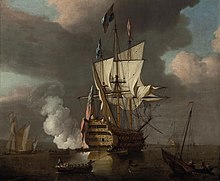Flagskib
Flagskibet eller kommandoskibet er det skib i en flåde eller en task force (flåde-styrke), hvor flådens/styrkens chef befinder sig om bord. Hvis styrkens chef har rang af admiral, kaldes dette skib også for admiralskib.
| Spire Denne artikel om sømilitære emner er en spire som bør udbygges. Du er velkommen til at hjælpe Wikipedia ved at udvide den. |
|
Medier brugt på denne side
an anchor symbol, fit for U+2693
One possible explanation could be that Rooke was under orders not to damage, let alone hazard, his flagship by exposing her to enemy fire such was her status as the symbolic flagship of the entire Navy and, in effect, a national icon. There is no documentary evidence to support such a theory yet it remains a mystifying fact that she never participated in any of the great sea-fights of her era despite several periods as flagship to successive commanding admirals. For unspecified reasons, she was effectively rebuilt by Master Shipwright J. Rosewell at Chatham between 1723 and 1729, even though details of her later career are equally sparse. Reclassed as a 90-gun 2nd Rate in 1756, three years later she was made Guardship in the Downs, a position of some significance, especially in time of war, as was the case from 1756-63. Further reduced to an 80-gun ship in 1763, perhaps as a result of the restoration of peace, she was broken up at Chatham a few years later, probably in 1766 although some sources state 1768. This lack of clarity concerning the precise year of her demise somehow reflects the whole of her sixty-year career which started with such promise yet achieved so little.



